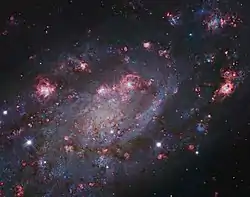NGC 2404
NGC 2404 is massive H II region inside NGC 2403, a spiral galaxy in Camelopardalis. It was discovered on February 2, 1886 by Gulliaume Bigourdan. NGC 2404 is approximately ≈ 2000 ly in diameter, making it one of the largest H II regions so far known. NGC 2404 is even larger than the Tarantula Nebula, one of the largest and most active H II regions in Local Group. NGC 2404 is 83 times larger than Orion Nebula, and if it would be at same distance, it would cause visible shadows. It is the largest H II region in NGC 2403, and lies at the outskirts of the galaxy, making striking similarity with NGC 604 in M33, both in size and location in host galaxy. This H II region contains 30-40 Wolf-Rayet stars,[2] and unlike Tarantula Nebula, but similar to NGC 604, the NGC 2404's open cluster is probably much less compact, so it probably looks like as a large stellar association. This H II region is probably only a few million years old.
| Emission nebula | |
|---|---|
| H II region | |
 NGC 2404 is the giant H II region to the left | |
| Observation data: J2000 epoch | |
| Right ascension | 07h 36m 51.4s[1] |
| Declination | +65° 36′ 09″[1] |
| Distance | 8,000,000 ly (2,454,000 pc) |
| Apparent magnitude (V) | +16.9 |
| Constellation | Camelopardalis |
| Physical characteristics | |
| Radius | ≈ 1000 ly |
| Absolute magnitude (V) | -14.5 |
| Notable features | Massive H II region, the largest one in NGC 2403. |
References
- "NASA/IPAC Extragalactic Database". Results for NGC 2403. Retrieved 2006-11-21.
- Finlay, W. H. (April 18, 2006). Concise Catalog of Deep-sky Objects: Astrophysical Information for 500 Galaxies, Clusters and Nebulae. Springer Science & Business Media. ISBN 9781852338510 – via Google Books.